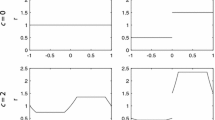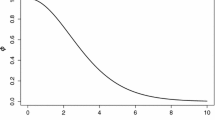Abstract
A difficulty in using diffusion models to predict large scale animal population dispersal is that individuals move differently based on local information (as opposed to gradients) in differing habitat types. This can be accommodated by using ecological diffusion. However, real environments are often spatially complex, limiting application of a direct approach. Homogenization for partial differential equations has long been applied to Fickian diffusion (in which average individual movement is organized along gradients of habitat and population density). We derive a homogenization procedure for ecological diffusion and apply it to a simple model for chronic wasting disease in mule deer. Homogenization allows us to determine the impact of small scale (10–100 m) habitat variability on large scale (10–100 km) movement. The procedure generates asymptotic equations for solutions on the large scale with parameters defined by small-scale variation. The simplicity of this homogenization procedure is striking when compared to the multi-dimensional homogenization procedure for Fickian diffusion,and the method will be equally straightforward for more complex models.
Similar content being viewed by others
References
Andro, D. A., Karieva, P. M., Levin, S. A., & Okubo, A. (1990). Spread of invading organisms. Landsc. Ecol., 4, 177–188.
Baeten, L. A., Powers, B. E., Jewell, J. E., Spraker, T. R., & Miller, M. W. (2007). A natural case of chronic wasting disease in a free-ranging moose (Alces alces shirasi). J. Wildl. Dis., 43, 309–314.
Demaret, L., Eberl, H. J., Efendiev, M. A., & Maloszewski, P. (2009). A simple bioclogging model that accounts for spatial spread of bacteria. Electron. J. Differ. Equ., 17, 51–69.
Dewhirst, S., & Lutscher, F. (2009). Dispersal in heterogeneous habitats: thresholds, spatial scales, and approximate rates of spread. Ecology, 90, 1338–1345.
Fisher, R. A. (1937). The wave of advance of advantageous genes. Ann. Eugenics, 7, 355–369.
Fitzgibbon, W. E., Langlais, M., & Morgan, J. J. (2001). A mathematical model of the spread of feline leukemia virus (FeLV) through a highly heterogeneous spatial domain. SIAM J. Math. Anal., 33, 570–588.
Holmes, E. E., Lewis, M. A., Banks, J. E., & Veit, R. R. (1994). Partial differential equations in ecology: spatial interactions and population dynamics. Ecology, 75, 17–29.
Holmes, M. H. (1995). Introduction to perturbation methods. New York: Springer.
Homer, C., Dewitz, J., Fry, J., Coan, M., Hossain, N., Larson, C., Herold, N., McKerrow, A., VanDriel, J. N., & Wickham, J. (2007) Completion of the 2001 National land cover database for the Conterminous United States. Photogramm. Eng Remote Sens., 73, 337–341.
Hooten, M. B., Garlick, M. J., & Powell, J. A. (2009). Advantageous change of support in inverse implementations of statistical differential equation models. In JSM proceedings, section on Bayesian statistical science (pp. 1847–1857). Alexandria: American Statistical Association.
Johnson, C. J., Pederson, J. A., Chappell, R. J., McKenzie, D., & Aiken, J. M. (2006). Oral transmissibility of prion disease is enhanced by binding to soil particles. Pub. Library Sci. Pathogens, 3, 874–881.
Kallen, A., Arcui, P., & Murray, J. D. (1985). A simple model for spatial spread and control of rabies. J. Theor. Biol., 116, 377–393.
Kareiva, P., & Odell, G. (1987). Swarms of predators exhibit “preytaxis” if individual predators use area-restricted search. Am. Nat., 130, 233–270.
Kierstead, H., & Slobodkin, L. B. (1953). The size of water masses containing plankton bloom. J. Mar. Res., 12, 141–147.
Kinezaki, N., Kawasaki, K., Takasu, F., & Shigesada, N. (2003). Modeling biological invasions into periodically fragmented environments. Theor. Popul. Biol., 64, 291–302.
Lewis, M. A., Hillen, T., & Lutscher, F. (2005). Spatial dynamics in ecology. IAS/Park City Math. Ser., 15, 3–21.
Logan, D. J. (2006). Applied mathematics (3rd ed.). Hoboken: Wiley-Interscience.
McFarlane, L. R. (2007). Breeding behavior and space use of male and female mule deer: An examination of potential risk differences for chronic wasting disease infection. Master’s thesis, Utah State University.
Meade, D. B., & Milner, F. A. (1992). Applied mathematics monographs: Vol. 3. SIR epidemic models with directed diffusion.
Miller, M. W., Williams, E. S., Hobbs, N. T., & Wolfe, L. L. (2004). Environmental sources of prion transmission in mule deer. Emerg. Infect. Dis., 10, 1003–1006.
Miller, M. W., Hobbs, N. T., & Tavener, S. J. (2006). Dynamics of prion disease transmission in mule deer. Ecol. Appl., 16, 2208–2214.
Miller, M. W., Swanson, H. M., Wolfe, L. L., Quartarone, F. G., Huwer, S. L., Southwick, C. H., & Lukacs, P. M. (2008). Lions, prions and deer demise. Public Libr. Sci. ONE, 3, 1–7.
Mitchell, A. R., & Griffiths, D. F. (1980). The finite difference method in partial differential equations. Norwich: Wiley.
Murray, J. D. (1980). On pattern formation mechanisms for Lepidopteran wing patterns and mammalian coat markings. Philos. Trans. R. Soc. Ser. B, 295, 473–496.
Okubo, A. (1980). Diffusion and ecological problems: mathematical models. New York: Springer.
Powell, J. A., & Zimmermann, N. E. (2004). Multiscale analysis of active seed dispersal contributes to resolving Reid’s paradox. Ecology, 85, 490–506.
Risken, H. (1986). The Fokker–Planck equation: methods of solutions and applications. Berlin: Springer.
Shigesada, N., & Kawasaki, K. (1997). Biological invasions: theory and practice. Oxford: Oxford University Press.
Shellam, J. G. (1951). Random dispersal in theoretical populations. Biometrika, 38, 196–218.
Swindale, N. W. (1980). A model for the formation of ocular dominance stripes. Proc. R. Soc. Lond. Ser. B, 208, 243–264.
Turchin, P. (1998). Quantitative analysis of movement. Sunderland: Sinauer.
Turing, A. M. (1952). The chemical basis of morphogenesis. Philos. Trans. R. Soc. Lond. Ser. B, 237, 37–72.
U.D.W.R. (2010). Utah Division of Wildlife Resources Wildlife News: Ideal weather could mean a few more deer. http://wildlife.utah.gov.
Williams, E. S. (2005). Chronic wasting disease. Vet. Pathol., 42, 530–549.
With, K. A. (2002). The Landscape ecology of invasive spread. Conserv. Biol., 16, 1192–1203.
Author information
Authors and Affiliations
Corresponding author
Rights and permissions
About this article
Cite this article
Garlick, M.J., Powell, J.A., Hooten, M.B. et al. Homogenization of Large-Scale Movement Models in Ecology. Bull Math Biol 73, 2088–2108 (2011). https://doi.org/10.1007/s11538-010-9612-6
Received:
Accepted:
Published:
Issue Date:
DOI: https://doi.org/10.1007/s11538-010-9612-6




